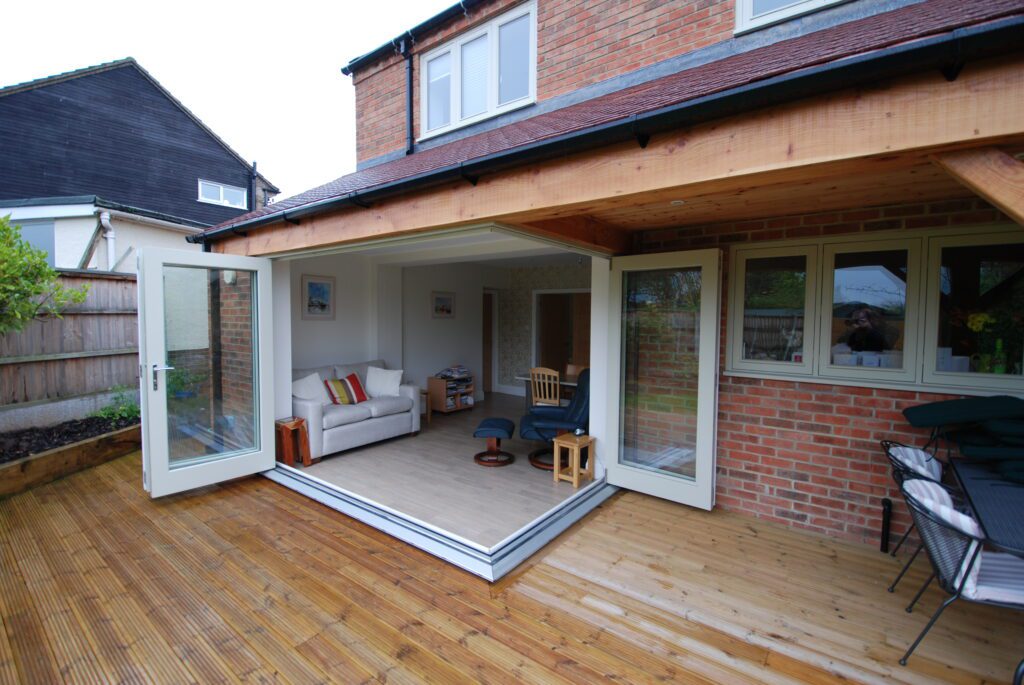What are floating corner bifold doors? How do builders create the unusual open corner effect on a room with sliding patio doors? Find out all about open corner sliding doors here…
Why Floating corner bifold doors?
Have you ever seen a room that has an ‘open corner’ – two walls that don’t join to create a wide open space? This is called a floating corner, and it is one of the most impressive features that you can build into a property. The effect of a floating corner is truly stunning. It’s almost as if the building is defying gravity. Our brains expect to see a supporting pillar in the corner of any room. A floating corner’s supporting post is conspicuous by it’s absence. It takes a second for our brains to register what’s missing. When it finally dawns, it comes as quite a surprise. How is the roof staying up? It’s not an illusion – welcome to the ‘wow factor’ of the floating corner.
What is a floating corner?
In simple terms – floating corner bifold doors are sliding doors that are installed in the corner of a room. When they are opened, the entire corner of the room is open. There is no supporting post, just wide open space. Normally a steel post would be fitted into the corner as both a support for the roof and for the doors to latch and lock into. When the doors are opened, the corner of the building is completely open and unsupported. The effect is used to create the much sought after design feature of open space.
Floating corners are perfect for homes with large patio areas. If you are a fan of al fresco dining and open living areas then a floating corner room is something you should definitely consider. Small rooms especially benefit from improved lighting and the impression of being connected to the outdoors, even when the doors are closed.
Not many properties have the capacity for a floating corner it has to be said, and in many houses the feature would look out of place. But if you have a suitable house, you can really create an attractive talking point. Floating corner are especially suited to modern homes and buildings and are a popular design feature to new, stylish homes with more modern design.

How to install floating corners
Installing a floating corner takes careful planning. The procedure need not be too complicated though.
Firstly your architect or planner will identify an area of your house that could benefit from improved light. The area should also connect to a pleasant part of the garden – there’s not much point in having a stunning wide open view of your compost heap! In truth, the location of the feature should be fairly obvious:
- Is the corner unobstructed outside?
- Does it connect with a particularly nice part of the garden?
Case Study
Gowercroft installed Accoya floating corner bifold doors during the refurbishment of Chestnut Way, Repton near Derby – read the full case study.
Read More
Option One – Cantilever beams
A floating corner has strengthening steel beams in the ceiling to provide the support that the post would normally provide. The structure very stable and the upper floors or roof are perfectly sound. The steel beams are built into the walls either side of the aperture. The weight of the building cantilevers the structure of the building away from the corner. The the upper floors are perfectly supported by their own weight.
This option is particularly well suited to older, more traditional properties. This technique works because the way the building holds it’s weight has been changed. No excessive weight presses down on the corner of the building, leaving the sliding doors free to move without any pressure that would eventually stop them from working.
Option Two – Supporting Poles set further back
The second option is to have supporting steel poles further into the gap, next to the where the support wall begins. You can make a design feature of the pole by decorating it with lights or painting it. This idea may work better in the more modern home where steel and more industrial design feel might be too out of place. Alternatively, the support pole can be built into the wall and hidden away.
Neither method is particularly better or worse than the other. The method used to support the upper floors will largely depend on the nature of the installation and personal preference.
Sliding or BiFolding Doors for your Floating Corner?
Again the choice of doors is down to location and personal preference as to whether you choose Sliding Doors or BiFold Doors.
Sliding Doors
Floating Corner Sliding Doors have smaller frames and larger glazed areas. They are perfect for creating the illusion of wide open space and bringing the outside indoors. The larger glass panels afford wider views of the surroundings, and are particularly well suited to rural locations. The panels overlap so even when only partially open they still allow the same amount of light into a room.
Lift and Slide Doors
Lift and Slide Doors can be fitted to larger apertures. The extra weight can be carried and the locking mechanism takes the strain from the doors when closed.

Bifolding Doors
Bifold doors work with a concertina effect. They consist of a number of panel that all fold together at a 90 degree angle. They provide the largest opening area of all three options as they fold very neatly together at their furthest extreme.
More information is available on WikiPedia about floating corner patio doors.